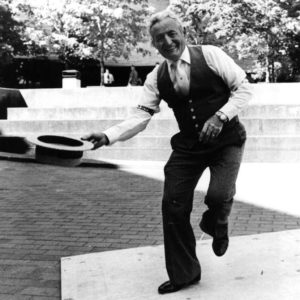When we were telling the tale of Dr. Dodge, one of old Albany’s well-known characters, we ran across the names of a number of other characters of the type that either don’t exist any more or just don’t get known. Perhaps it goes back to a time when the city was smaller (or more accurately, a huge part of the population hadn’t spread to the suburbs), and more people had entertainments, shopping locations, and street corners they passed by in common. In a city like that, it’s easier to notice and be noticed for standing out just a little.

For example, when we first moved to Albany, there was a downtown entertainer named Charlie “Taps” DiMura, who would give impromptu song and tap dance performances on North Pearl Street just because. His pedigree was solid, having performed on radio and TV amateur hours and at various local taverns and lounges in the ‘60s and beyond. He was in his 60s when he would just randomly perform in the vicinity of the bus stop just above State Street of a summer afternoon, and everyone seemed to know who he was.
Old time recorder of old time Albany, Edgar S. Van Olinda, peppered quite a few of his columns with stories of other Albany characters. Our attempts to find out anything more about them than Van Olinda related were generally doomed to failure, so most of what we present here owes entirely to him.
He said one of the best known “characters who added interest and mystery to the daily life of Albany men and women whom everybody knew by sight” was “Poppy” Sawyer, “pillar of Hope Baptist church on Clinton Avenue, philanthropist — he was a generous contributor to Memorial Hospital — and an extensive property owner in the South End.
“‘Poppy’ always wore a Prince Albert coat, and a high plug hat on the streets … ” Poppy lived for years at Franklin and Arch Streets and owned extensive real estate in the South End, including the Pearl Street Hotel, “which catered farmers and their rigs from the Helderbergs. … He was better known to the youth of the city than to their elders. Coming upon a group of boys in the vicinity of the Hope Baptist Church in Clinton Avenue, whose loose language shocked the proprieties, he would gently chide them for their minor offenses. he always carried a pocketful of Larabee’s animal crackers which he passed out to the offenders, and like the Pied Piper of Hamelen, gently led them into his Sunday School enrollment.”
“He had a compatriot in the person of Dr. Mary Walker, a Civil War surgeon with the Northern Army who was allowed by an act of Congress to effect men’s clothing. She also wore a high hat and Prince Albert coat around which she, to retain her femininity, wore a fur stole. It was difficult to tell these two persons apart at a short distance.” On another occasion, Van Olinda said of Dr. Walker that she was a familiar figure on the streets of Albany when legislative matters engaged her attention. He said she discarded female attire at age 29; “at formal gathering she wore a frock coat or formal evening dress but always the inevitable stovepipe hat.” (There’s much more to be said of Dr. Walker, which we will get to anon.) Van Olinda said that Dr. Leandre Dumouchel, organist at the Cathedral of the Immaculate conception, “appeared on the streets of Albany similarly attired.” More on Dr. Dumouchel to come as well.
Then there was Charles Halstead, mentioned numerous times in Van Olinda’s columns. He was better known as “Lemon Drop Charlie Giggie.” He got his “Lemon Drop” nickname for the habit of hanging out at the entrances to dance halls and offering lemon drops to the ladies. Giggie “always wore a ‘gates ajar’ collar and a crepe mourning band on his iron hat.” He would show up “at every dance with a paper bag filled with Kreicher’s famous citron-flavored long suckers. He stood at the door as soon as the orchestra struck up, and offered the ladies present to take a dip out his paper sack, but closing the container when the lady’s escort tried to get in on the handout.” Charmed, I’m sure.
“Down in the South End was ‘Pump Handle Pete,’ a young man whose daily stint took him to one of the many prevalent pumps of ‘Bonafettle’ where he assisted the women of the neighborhood to fill their receptacles for washing and cooking. It was said of him that he never got into the hub of Albany during his whole lifetime, being content to stay inside the South End perimeter.” “Bonafettle” was the German neighborhood, a corruption of the German for “bean quarter.”
There was a scribe named Edward McClure, “who established his outdoor office in front of the Home Savings Bank, writing visiting cards in his fine Spencerian hand, or engrossing scrolls for special occasions.” Beyond Van Olinda, we find no other mention of him, but in this age when there are once again poets for hire and professional calligraphers, we think he would have been right at home.
“And finally, there was ‘Mr. Peanut’ who went up and down North Pearl Street, handing out samples of Planers products. He wore a papier mache helmet, moulded in the form of a peanut, which when being removed at the end of his day, revealed a former English actor, down on his luck, but who was too proud to go on relief.” The actor’s name was not given.

Leave a Reply